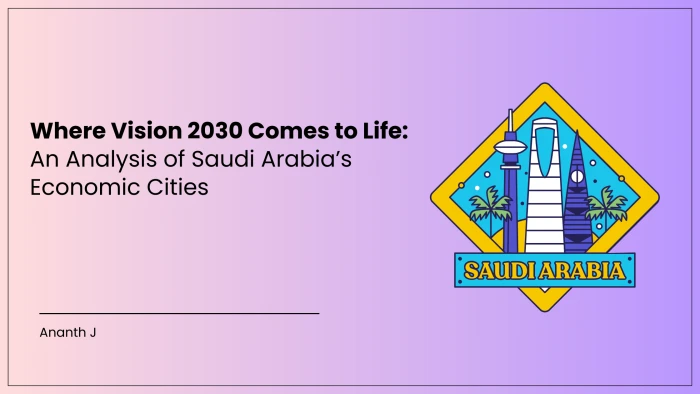Saudi Arabia's ambitious Vision 2030 program is strategically positioning the Kingdom as a global logistics and industrial hub/ The Economic Cities initiative serves as a critical vehicle for this transformation, designed to attract foreign investment, diversify the economy, develop non-oil sectors, and create employment opportunities for the Kingdom's growing population.
Together, these cities form the backbone of Saudi Arabia’s economic diversification strategy, each designed with a distinct industrial focus but united in driving the Kingdom’s global logistics and industrial ambitions.
King Abdullah Economic City
King Abdullah Economic City (KAEC), located on the Red Sea coast approximately 100 kilometers north of Jeddah, exemplifies Saudi Arabia's strategic advantage as the region's fastest-growing manufacturing and logistics hub. Spanning 173 square kilometers, KAEC was launched in 2005 as part of the Kingdom's Economic Cities initiative and Vision 2030 program.
The development houses King Abdullah Port, which has emerged as a critical maritime gateway facilitating seamless connectivity through integrated road, rail, and air networks.
The port has been recognized as the world's most efficient container port by the World Bank and S&P Global. With a planned capacity to handle up to 25 million containers annually and deep-water berths of 18 meters that can accommodate the world's largest ships, the port is a cornerstone of KAEC's logistics capabilities
Jazan Economic City
Jazan Economic City (JEC), also known as Jazan City for Primary and Downstream Industries (JCPDI), is another flagship development in Saudi Arabia's Jizan Province, strategically located on the Red Sea about 60 km north of Jazan city.
JEC is designed with a multi-sectoral approach, targeting several high-impact industries including heavy industries (petrochemicals, energy, mining, and metals processing), manufacturing, logistics and trade, renewable energy, food processing, and tourism and services.
A significant development within JEC is the downtown area, which has received a $23 billion investment for construction, including site leveling, infrastructure, and housing. The tourism focus includes plans for an aquapark, conference and exhibition center, amusement park, shopping mall, marina, yacht club, parks, beach resort, and hotels.
In 2023, a Special Economic Zone (SEZ) was launched within JCPDI, targeting food industries, manufacturing, mining and metals, and logistics.
Ras Al-Khair Industrial City
Ras Al-Khair Industrial City, located on the Arabian Gulf coast in the northeast of Saudi Arabia, specializes in mining, minerals processing, and heavy industries, particularly aluminum and phosphate.
This industrial city is central to Saudi Arabia's efforts to develop its mining sector and diversify industrial output beyond petroleum-based products. Ras Al-Khair features a specialized port capable of handling bulk minerals and industrial products, supporting the mining and metals cluster in the region. It specifically specializes in shipbuilding and maritime industries.
The port is integrated with the North-South Railway and road networks, enhancing its logistics capabilities and connectivity to other parts of the Kingdom.
How Economic Cities Deliver on Vision 2030
Strategic Geographic Advantage and Infrastructure Excellence
The Kingdom's Economic Cities capitalize on Saudi Arabia's unique geographic positioning at the crossroads of Europe, Asia, and Africa. Further, infrastructure is a critical enabler for economic development in these cities, reducing trade costs, facilitating economies of scale, and supporting efficient production and specialization.
Recent infrastructure investments have significantly enhanced the cities' logistics capabilities. The government's focus on establishing automated storage and retrieval systems (ASRS) in key economic zones including Jeddah, Riyadh, and Dammam has substantially improved distribution efficiency.
Major infrastructure projects connecting the Economic Cities include the Saudi Landbridge Project, a flagship rail initiative designed to connect the Red Sea (Jeddah/KAEC) to the Arabian Gulf (Dammam/Riyadh), passing through major economic hubs. The Haramain High-Speed Railway enhances passenger connectivity between KAEC, Jeddah, Makkah, and Madinah, supporting business travel and tourism.
Industrial Development and Investment Attraction
The Saudi government's commitment to industrial cluster development within these cities reflects substantial financial backing. The National Industrial Development and Logistics Program (NIDLP) continues to drive significant investment flows, with the government seeking to attract $3 trillion in foreign investment to promote economic development and technology transfer.
Each Economic City maintains specialized industrial focus areas: Jazan Economic City concentrates on energy and mining sectors, while Ras Al-Khair specializes in shipbuilding and maritime industries.
The cities offer compelling investment incentives including tax benefits, 100% foreign ownership opportunities, and streamlined regulatory frameworks.
The business-friendly policies, combined with advanced smart technologies and renewable energy integration, have positioned the Economic Cities as attractive destinations for international corporations seeking regional headquarters and manufacturing bases.
Technological Innovation and Smart City Development
Saudi Arabia's Economic Cities are at the forefront of technological innovation, serving as testbeds for advanced technologies and digital transformation. These cities are leveraging cutting-edge innovations to drive economic diversification, enhance urban living, and position Saudi Arabia as a global leader in smart city development.
The cities are being equipped with robust 5G networks, enabling high-speed, low-latency communication essential for smart city applications, autonomous vehicles, and IoT devices. NEOM, for example, partnered with stc Group to build a 5G network infrastructure, supporting its vision of a fully connected, cognitive city.
Collaborations with global tech leaders are establishing cloud platforms and data centers, providing the backbone for digital services, big data analytics, and AI-driven solutions
Artificial intelligence spending alone in Saudi Arabia is projected to surpass $720 million in 2024, reaching $1.9 billion by 2027 at a compound annual growth rate of 40%. According to PwC research, AI is expected to contribute $135 billion to the Saudi economy, with Economic Cities serving as primary implementation hubs for these technological innovations.
Challenges and Future Outlook
Despite their promising potential, Saudi Arabia's Economic Cities face several challenges:
- The gap between strategic vision and practical implementation.
- Organizational capabilities and governance issues, such as bureaucratic delays, unclear regulatory frameworks, and challenges in inter-agency coordination.
- Attracting and retaining investment.
- Global economic uncertainties and competition from other regional hubs.
Nevertheless, the future outlook for Saudi Arabia's Economic Cities remains positive. Experts anticipate transformative growth for Saudi Arabia's logistics sector, with Economic Cities playing a pivotal role in linking global supply chains and facilitating international trade.
The success of Saudi Arabia's Economic Cities will be instrumental in achieving Vision 2030's diversification objectives and cementing Saudi Arabia's role as a global trade and logistics leader. In redefining industry, logistics, and innovation, Saudi Arabia’s Economic Cities are where Vision 2030 moves from aspiration to reality.
Sources:
https://www.centuroglobal.com/article/saudi-arabia-vision-2030
https://saudilogisticsconsulting.com/insights/articles/saudi-arabia-logistics-market-a-multi-billion-dollar-growth-story
https://www.mordorintelligence.com/industry-reports/saudi-arabia-freight-and-logistics-market#
https://www.pif.gov.sa/en/our-investments/our-portfolio/king-abdullah-economic-city
https://millionplus.com/king-abdullah-economic-city-saudi-arabia-vision-2030/
https://www.pif.gov.sa/en/our-investments/our-portfolio/king-abdullah-economic-city/
https://www.gulfconstructiononline.com/Article/1628999/Work_begins_on_$23bn_Jazan_Citys_downtown
https://araburban.org/en/infohub/projects/?id=9536#
https://connections.nortonrosefulbright.com/post/102iucr/unveiling-jazans-economic-potential-insights-from-the-jazan-investment-forum-20#
https://www.brookings.edu/articles/the-economics-of-infrastructure-in-a-globalized-world-issues-lessons-and-future-challenges/
https://www.linklaters.com/en-us/knowledge/publications/alerts-newsletters-and-guides/2024/august/22/saudi-arabias-new-investment-law-2024#
https://www.smartcitiessaudiexpo.com/a-deep-dive-into-saudi-arabias-tech-driven-smart-cities/
https://www.pwc.com/m1/en/media-centre/articles/saudi-arabia-logistics-sector-pioneering-pathways-for-global-connectivity.html#


